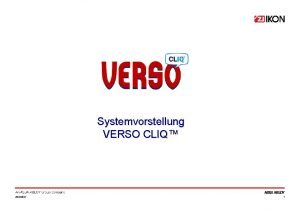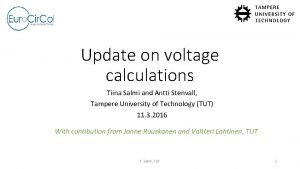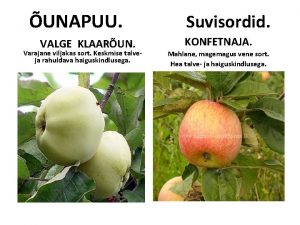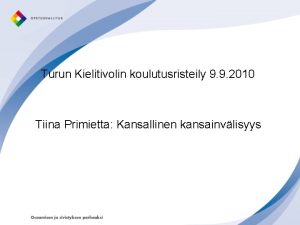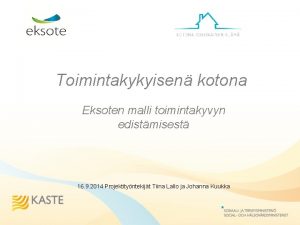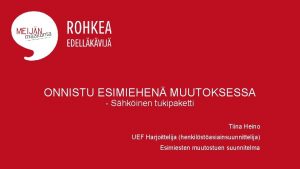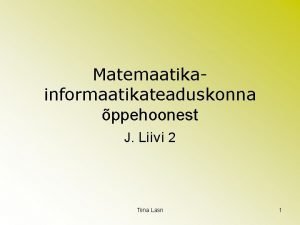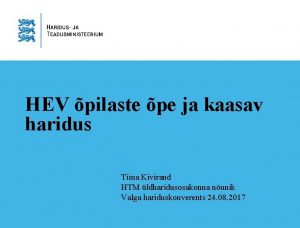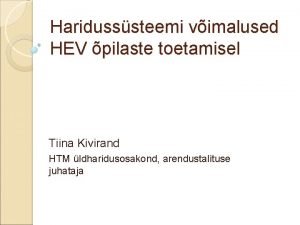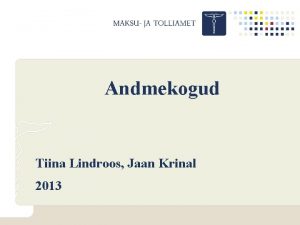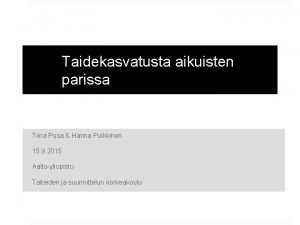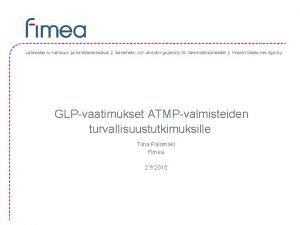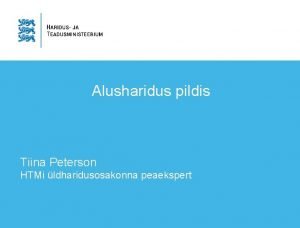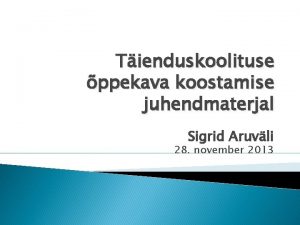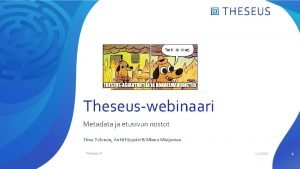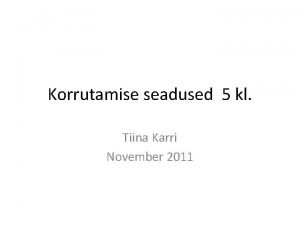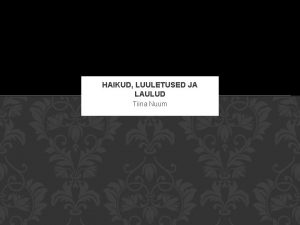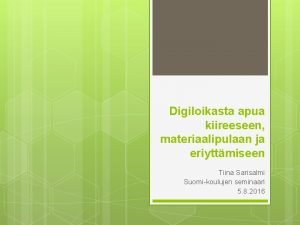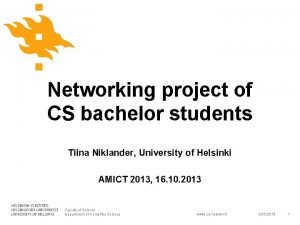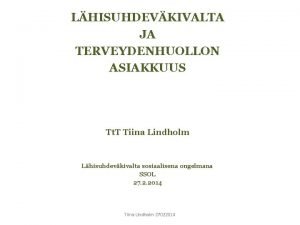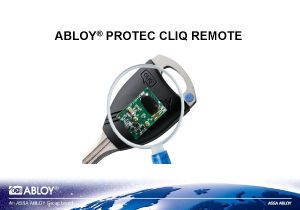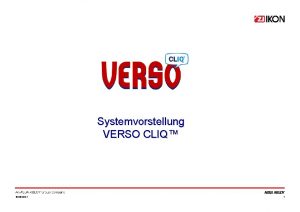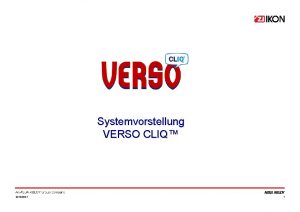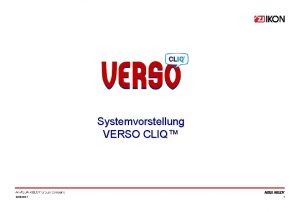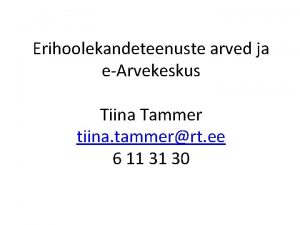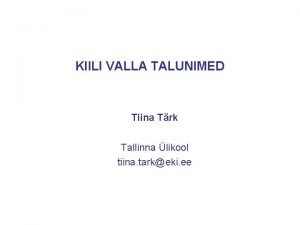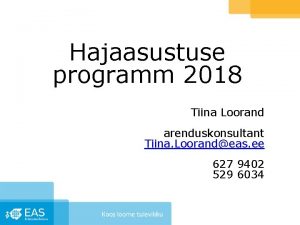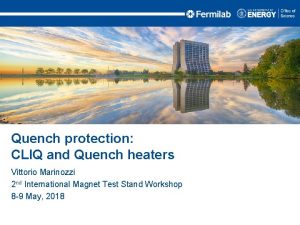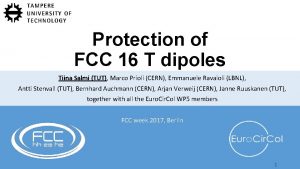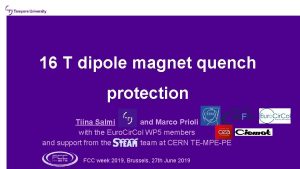Status with CLIQ and QH protection designs Tiina



































- Slides: 35

Status with CLIQ and QH protection designs Tiina Salmi (TUT), Marco Prioli (CERN), Emmanuele Ravaioli (LBNL) Euro. Cir. Col WP 5 coordination meeting 16 th May 2017 1

Outline • Comparison of CLIQ simulations using COMSOL and LEDET • Design of protection with quench heaters (QH) and CLIQ • Plan for FCC-week • Talk: Protection with heaters, protection with CLIQ, protection with QH + CLIQ, comparison, prospects • Poster (Marco): Ways to reduce voltages • Poster (Junjie): Mechanical modeling during quench • Marco: LEDET-PSpice co-simulation with STEAM and plan for the poster • Junjie: Poster 2

Comparison of COMSOL and LEDET • Work together with Marco (Comsol) and Emmanuele (guidance with LEDET) • Consider the CLIQ designs by Marco, as presented in Barcelona • Build LEDET model for all magnets, update COMSOL models so that the parameters and assumptions match as closely as possible 3

Block, V 20 ar Magnet parameters CLIQ configuration Magnet Block, V 20 ar l (m) 14. 3 Imag (A) 12040 Ld, nom (m. H/m) 17. 57 Cable Detection delays 20 ms CCLIQ=20 m. F, UCLIQ=2 k. V HF-cable LF-cable 13. 05 x 2. 1 13. 05 x 1. 25 Number of strands STEAM 21 / LEDET 20 STEAM 35 / LEDET 34 Strand diam. (mm) STEAM 1. 155 / LEDET 1. 1835 STEAM 0. 705 / LEDET 0. 7153 0. 8 2. 3 22. 00 13. 66 Cable w x t (bare) (mm) Cu/SC Srand area (mm 2) Cable ins. (mm) 0. 15 RRR 100 Fil. twist (mm) 14 Strand twist (mm) 180 Material properties NIST Jc-fit L 2 + L 1 + L 3 − L 4 − From B. Bordini with Tc 0 = 16 K, Bc 20 = 29. 38 T, α = 0. 96, C 0 = 267845 A/mm 2 T 4

Block: Simulated current decay and final temperatures COMSOL / STEAM MIITs 16. 7 Hotspot 309 K LEDET MIITs 16. 9 Hotspot 326 K Comparison • Difference in CLIQ current • ΔMIITs < 2% • ΔTHS < 6% Coil temperature at t = 0. 5 s • Small difference in the temperature distribution • We know that the field distribution is different due to iron simulation 5

Block: Simulated current decay and final temperatures COMSOL / STEAM LEDET Comparison • Difference in CLIQ current • ΔMIITs < 2% • ΔTHS < 6% Coil temperature at t = 0. 5 s • Small difference in the temperature distribution • We know that the field distribution is different due to iron simulation 6

Block: Simulated voltages COMSOL / STEAM Vmax = 1. 32 k. V LEDET Vmax 1. 68 k. V Comparison • ΔVmax = ~400 V! • Voltage distribution quite similar Coil ground voltage at = 0. 1 s Coil ground voltage at = 0. 08 s • To quantify the impact of iron (non)linearity, we repeated the simulation without iron 7

Block, NO IRON: Simulated current decay and final temperatures LEDET COMSOL / STEAM MIITs 16. 9 Hotspot 298 K MIITs 17. 1 Hotspot 306 K Comparison • Still a difference in CLIQ current • ΔMIITs < 2% • ΔTHS < 3% • Similar MIITs- THS curve Coil temperature at t = 0. 5 s • Still small differences in temperature distribution • Could the layer to layer propagation explain them? 8

Block, NO IRON: Simulated voltages COMSOL / STEAM Vmax = 1. 45 k. V LEDET Vmax 1. 73 k. V Comparison • ΔVmax = ~300 V • Voltage distribution quite similar • What is the numerical uncertainty related to time-stepping? Coil ground voltage at = 0. 1 s Coil ground voltage at = 0. 08 s 9

Time -step convergence with LEDET • Case with Block with no iron • Increasing the time step decreases voltage and hotspot temperature • Faster quench in the windings? • Numerical error is in the range of discrepancy with COMSOL • We could estimate that the error bar related to temperature is ~10% and to voltages ~20% in these simulations • Does not completely explain the difference with CLIQ behaviour Time step (s) 1 E-04 1 E-05 5 E-06 2 E-06 5 E-07 COMSOL T_HS (K) 287 295 298 306 308 298 T_max, coil (K) 186 192 194 199 198 190 MIITs 16. 52 16. 77 16. 85 17. 14 17. 25 16. 9 Temp. Volt. V_gnd (V) 1510 1590 1620 1730 1762 1450 10

Costheta, 22 b-37 -optd 7 f 8 Magnet parameters CLIQ configuration Magnet Costheta, 22 b-37 -optd 7 f 8 l (m) 14. 3 Imag (A) CCLIQ=20 m. F, UCLIQ=2 k. V 11800 Ld, nom (m. H/m) Cable Detection delays 20 ms 18. 4 HF-cable LF-cable 13. 2 x 1. 950 13. 65 x 1. 264 Number of strands 22 STEAM 37 / LEDET 38 Strand diam. (mm) 1. 1 STEAM 0. 7 / LEDET 0. 6905 Cu/SC 0. 8 2. 3 20. 907 STEAM 14. 24 / LEDET 14. 230 Cable w x t (bare) (mm) Srand area (mm 2) Cable ins. (mm) 0. 15 RRR 100 Fil. twist (mm) 14 Strand twist (mm) 180 Material properties NIST Jc-fit From B. Bordini with Tc 0 = 16 K, Bc 20 = 29. 38 T, α = 0. 96, C 0 = 267845 A/mm 2 T 11

Cosθ: Simulated current decay and final temperatures LEDET COMSOL / STEAM PRELIMINARY MIITs 18. 3 Hotspot 338 K MIITs 17. 6 Hotspot 304 K Comparison PRELIMINARY • Difference in CLIQ current • ΔMIITs ~4% • ΔT_Hs < 12% Coil temperature at t = 0. 5 s Coil temperature at t = 1. 0 s PRELIMINARY • Similar differences than in the Block simulation 12

Cosθ: Simulated voltages LEDET COMSOL / STEAM PRELIMINARY Vmax ~2500 V Comparison PRELIMINARY • High initial peak in both simulations • Significant difference in peak voltages during the decay Coil ground voltage at = 0. 1 s 13

Summary of the LEDET – COMSOL/STEAM cross-check • Results are relatively close, but we have uncertainties and differences: • Temperatures reasonably close • Voltages and CLIQ behaviour needs further investigation • The time-step convergence needs further investigation COMSOL LEDET Time (s) Current (A) CLIQ in Block with no iron Time (s) 14

Design procedure for heaters + CLIQ 1. Choose baseline CLIQ design and baseline heater design 2. Quench simulation: - Heater delays are simualted with Co. HDA - Heat contribution by CLIQ is not considered - Compute time for the quench to propagate between heating stations - Assume 20 m/s - Input the quench delays for the heater covered turns in LEDET - Simulate CLIQ discharge with LEDET and the heater covered turns quench with the defined delays 3. Adjust CLIQ voltage and capacitance so that together with heaters the THS <350 K and voltages minimized 4. Adjust heater design to see if the temperature and voltage can be further reduced 5. Adjust CLIQ design to the new heater design 15

1. Baseline CLIQ design • The baseline CLIQ connection seems good because it deposits heat between the pancakes. Heaters can be positioned on the coil surfaces, no need for interlayer heaters QH’s Interfilament coupling loss (IFCL) deposited by CLIQ before the cable quenches (after the quench IFCL is set to 0) QH’s LEDET 16

1. Baseline heater design • Cu-plated stainless steel strip, ins. 0. 075 mm polyim. • Heater strip width 15 mm, heating station length 70 mm, period 400 mm • LHC HFU 900 V, 7 m. F: Power 4 strips with one HFU • 4 HFU’s / magnet aperture, 8 HFU’s / 2 -aperture magnet HF_L 4 LF_L 4 Quench also at low B and I 96 W/cm 2, RC = 30 ms HF_L 1 LF_L 1 17

2. -3. Simulation CLIQ + heaters, CLIQ power adjustment • Considering the baseline heater design: CLIQ Voltage (V) CLIQ Capacitance (m. F) Stored energy in CLIQ unit (k. J) Hotspot temperature (K) Max voltage to ground (V) 2000 20 40 316 1500 1000 20 10 339 1330 1000 10 5 342 1280 500 LHC HFU, so let’s give this a try first 450 900 10 1. 25 376 1320 14 1. 42 378 1200 7 2. 84 349 1400 Good option • Only CLIQ; 2000 V, 20 m. F, 40 k. J, 326 K, 1680 V (LEDET) • By adding QH the CLIQ energy can be substantially reduced and the voltages are lower 18

Improving heater design – Note the potential in voltage reduction • CLIQ with 900 V, 7 m. F • Increase of heat in L 1 could help in voltages: • Period of L 1 strips to 30 cm, those of L 4 to 60 cm • LF strips in series and HF strips in series so keep the same Rtot • Result: Tmax = 345 K, 1320 V to gnd ( at 100 ms) • Period of L 1 strips to 25 cm, those of L 4 to 100 cm • Result: Tmax = 344 K, 1310 V to gnd HF_L 4 LF_L 4 • The functions of the heaters: • L 4 : Low current, quenches, but not so fast • L 1: Voltage reduction at high current. Quench fast! • L 1 HF heater HS length to 50 mm, period to 180 mm • Result: 343 K, 1300 V HF_L 1 LF_L 1 19

Final adjustment of CLIQ power • QH design: • HF_L 4 and LF_L 4: HS 7 cm, period 100 cm • LF_L 1: HS 7 cm, period 25 cm • HF_L 1: HS 5 cm, period 18 cm • With QH + CLIQ 900 V / 7 m. F we had: 343 K, 1300 V • With QH + CLIQ 1000 V / 10 m. F we have: 337 K, 1230 V Only CLIQ; 2000 V, 20 m. F, 326 K, 1680 V Nearing the specifications The voltage is a challenge, we can reduce with careful optimization, still hard to get below 1000 V without increasing the complexity (Remember we also have large uncertainty) • Could be advantageous to design CLIQ and QH for similar powering units (less cost, less complex) 20

Simulation with Coodi • Case 1: CLIQ with 900 V / 7 m. F, heater design with - L 1_HF heater 5/18 cm for LF cable, and for HF Cable 7 / 25 cm -L 4 heaters 7/ 100 cm • I took all the quench delays to be the same than in LEDET (CLIQ and heater delays), and input them as quenching times to Coodi • Case 2: Also LEDET with quench delays (CLIQ and QH), no oscillation of magnet current • Case 3: LEDET and Coodi with 40 ms uniform quench delay CASE Thotspot (K) V_gnd (V) MIITs (MAAs) 1. LEDET (CLIQ comp. + QH delays input) 343 1300 17. 34 1. Coodi (CLIQ delays input + QH delays input) 341 1310 17. 6 2. LEDET (CLIQ delays input + QH delays input) 342 1240 17. 35 3. Coodi (40 ms) 351 992 18. 31 3. LEDET (40 ms) 354 1031 18. 45 21

Comparison of current decays LEDET vs. Coodi LEDET and Coodi with the input quench delays for CLIQ and QH LEDET with CLIQ and QH LEDET and Coodi with 40 ms uniform delay 22

Plan for the FCC-week 1. Protection with heaters only 2. Protection with CLIQ only 3. Protection with QH + CLIQ 4. Comparison 5. Prospects of high-field magnet protection 23

1. Protection with heaters only (Block (V 15 ar), and Cosθ (22 b-37 -optd 6 f 6)) QH 4 A QH 2 A QH 4 B QH 3 A QH 3 B QH 2 B QH 4 C QH 1 A QH 1 B In the block each HFU consists of a 19. 2 m. F capacitor charged to 450 V. QH 2 C QH 3 C QH 4 D In the cosθ eahc HFU consists of a 14. 0 m. F capacitor charged to 450 V. Circuit QH Strips HFU#1 HFU#2 HFU#3 HFU#4 1 B || 1 A || 2 B 2 C || 3 A || 3 B || 3 C 4 A || 4 B 4 C || 4 D Strip width HS/ period PQH(0) (cm) (W/cm 2) 1. 0 3/15 70 1. 0 6/30 70 1. 4 6/35 100 τRC (ms) 30 30 24

2. Protection with CLIQ only • The baseline designs by Marco as presented at the Barcelona meeting (parameters updated) • Costheta and Block as presented here • Put LEDET or STEAM? Tell about the uncertainties? • Add Commoncoil (LEDET model almost ready) 25

3. Protection with CLIQ and heaters • Block: as presented here • Costheta: Putting heaters only on outer layer • Commoncoil: If everything goes super-smoothly, time to do this as well • Do analysis for all currents (1000 A – 105% of Inom) • Some uncertainty analysis for one of the options 26

4. Comparison QH only CLIQ only (LEDET) CLIQ + QH Block Cosθ Hotspot temperature (K) 346 341 ~330 330 Voltage to ground (V) 1400 1150 1700 ~2500 1230 Energy of QH system (Jk) 90 45 40 40 14 For the older magnet versions (still after the parameter update). Ok? (which one to put / comsol or LEDET simulation? ) – LEDET maybe because C-c will have only LEDET C-c Block Cosθ C-c Maybe updated if manage to use the LEDET heater model and include CLIQ contribution 27

Prospects in high-field magnet hybrid protection • Modeling tools accuracy needs to be confirmed • Requires further studies and also experimental validation • In the designed magnets the hotspot temperature can be dealt with CLIQ or heaters • Voltages will be an issue • Heaters only results in many HFUs • CLIQ only results in high voltages • With heaters and CLIQ - CLIQ energy can be reduced - HFUs can be reduced - Voltages are reduced While keeping the hot spot temperature 28

Plan for the poster M. Prioli, T. Salmi, E. Ravaioli 29

Voltage to ground in a chain of magnets Block coil field model Vgnd, magnet, max = 1 k. V • Voltage to ground is one of the limiting parameters of FCC magnet designs • High voltages might affect the reliability of a magnet • In its study, different aspects have to come together • Circuit layout → circuit model • Magnet design → field model FCC circuit model PC Cfilt REE M 1 M 2 M 36 M 35 CCLIQ Mn M 18 M 19 Vgnd, circuit, max = 1 k. V 30

LEDET tool • Developed and maintained by E. Ravaioli, LBNL • Pros • Fast simulation tool, suitable for the optimization of CLIQ design • Cons • Only simple circuits with 1 magnet and 2 currents L 2 L 1 L 3 L 4 31

LEDET + PSPICE co-simulation • Integration of LEDET into the STEAM framework to extend its capabilities • Field model: LEDET, model provided by Tiina • Circuit model: Pspice • Co-simulation: Field-circuit coupling Block coil field model LEDET FCC circuit model Cadence PSpice Lfilt PC Cfilt REE M 1 M 2 M 36 M 35 Mn CCLIQ M 18 M 19 32

Validation of co-simulation against monolithic simulation 33

Ideas for the reduction of the voltage to ground 1. More sophisticated CLIQ configurations e. g. CLIQ connection on the layer jump within a double-pancake 2. CLIQ effect on the circuit 3. Two magnetically coupled circuits for HF and LF cables can magnet designs profit from two different cable currents? 4. Internal diodes L 1 L 2 L 3 L 4 L 5 L 6 L 7 L 8 L 4 L 3 L 2 L 1 L 8 L 7 L 6 L 5 34

Poster about mechanical modeling during quench (Junjie Zhao) 35
 Cliq designs
Cliq designs Verso cliq
Verso cliq Cliq bus
Cliq bus Tiina salmi
Tiina salmi Sort
Sort Tiina strengell kokemuksia
Tiina strengell kokemuksia Tiina primietta
Tiina primietta Tiina lallo
Tiina lallo Tiina heino
Tiina heino Tiina kroll
Tiina kroll Liivi 2
Liivi 2 Tiina kivirand
Tiina kivirand Tiina kivirand
Tiina kivirand Prepeat printer pronunciation
Prepeat printer pronunciation Tiina lindroos
Tiina lindroos Tiina kivirand
Tiina kivirand Hanna pulkkinen
Hanna pulkkinen Tiina merkuljeva
Tiina merkuljeva Tiina santonen
Tiina santonen Tiina primietta
Tiina primietta Tiina peterson
Tiina peterson Tiina unukainen
Tiina unukainen Tiina tolonen
Tiina tolonen Tiina larven
Tiina larven Korrutamise jaotuvusseadus
Korrutamise jaotuvusseadus Tiina juhansoo
Tiina juhansoo Haiku linnast
Haiku linnast Tee ajatuskartta netissä
Tee ajatuskartta netissä Tiina koskelainen
Tiina koskelainen Tiina juhansoo
Tiina juhansoo Tiina larsson kerava
Tiina larsson kerava Tiina niklander
Tiina niklander Tiina markkanen
Tiina markkanen Lähisuhdeväkivallan muodot
Lähisuhdeväkivallan muodot Tiina ranta laurea
Tiina ranta laurea Tiina hoffman
Tiina hoffman

